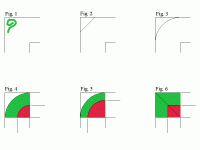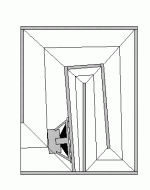Calculating the length of the bends in a folded horn is confusing.
Figures 1, 2 & 3 are the most common bends. For low frequency waves,
they are nearly identical, with a small edge given to figure 3. The
green squiggle in figure 1 represents turbulence.
Figure 4 would seem to be the way to go, until you consider that
the outer part of the bend (the green area) has 3 times the area
that the inner (red) part has. Also, the length of the dividing
line is WAY below (30% below) the experimental data.
In figure 5, the "center" line is moved from 50% of the duct width
to 70%. Now, the green area is equal to the red area, and the
length of the line dividing the red from the green agrees within
a few percent of experimental data.
Figure 6 is nearly as good, and a lot less trouble. Just draw a
diagonal line in each corner, and connect the center points of each
line. The length of that line is within a few percent of the horn
length as calculated using figure 5.
Figures 1, 2 & 3 are the most common bends. For low frequency waves,
they are nearly identical, with a small edge given to figure 3. The
green squiggle in figure 1 represents turbulence.
Figure 4 would seem to be the way to go, until you consider that
the outer part of the bend (the green area) has 3 times the area
that the inner (red) part has. Also, the length of the dividing
line is WAY below (30% below) the experimental data.
In figure 5, the "center" line is moved from 50% of the duct width
to 70%. Now, the green area is equal to the red area, and the
length of the line dividing the red from the green agrees within
a few percent of experimental data.
Figure 6 is nearly as good, and a lot less trouble. Just draw a
diagonal line in each corner, and connect the center points of each
line. The length of that line is within a few percent of the horn
length as calculated using figure 5.
Attachments
Tom Danley said: "A word about folding, one mistake made in horn folding is to make the horn passage significantly less volume
that it was when straight. The air in a bend has a rotary motion and so momentarily has rotational properties, the effect of this is
that the air has slightly more mass (inertia? DS) than in a straight section. This in turn allows a small reduction in acoustic length for that section but it is small. When I lay out a bend I usually try to keep the total volume close to that of a straight horn. With increasing frequency, a bend's dimension will have an impact on the sound. At the point where the difference in acoustic path length around
the inside and outside of the bend reaches 1/2 wavelength, there will be a deep notch in the response. Above this frequency
will be a pattern of notches and so on as the dimensions are N 1/2 wavelengths. If you have to make a bend, make it where the dimensions are small, make the angle as small as possible."
that it was when straight. The air in a bend has a rotary motion and so momentarily has rotational properties, the effect of this is
that the air has slightly more mass (inertia? DS) than in a straight section. This in turn allows a small reduction in acoustic length for that section but it is small. When I lay out a bend I usually try to keep the total volume close to that of a straight horn. With increasing frequency, a bend's dimension will have an impact on the sound. At the point where the difference in acoustic path length around
the inside and outside of the bend reaches 1/2 wavelength, there will be a deep notch in the response. Above this frequency
will be a pattern of notches and so on as the dimensions are N 1/2 wavelengths. If you have to make a bend, make it where the dimensions are small, make the angle as small as possible."
- Status
- This old topic is closed. If you want to reopen this topic, contact a moderator using the "Report Post" button.

